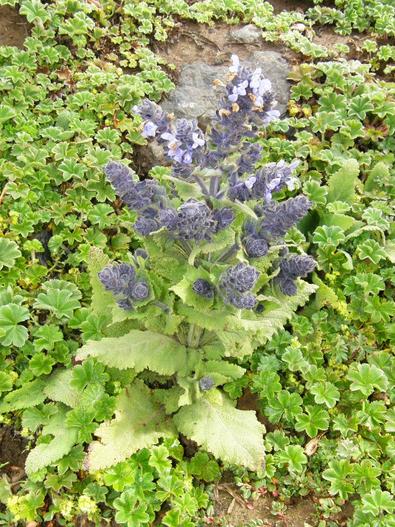Minty Kilimanjaro Sage
(Salvia merjamie)
Minty Kilimanjaro Sage (Salvia merjamie)
/
/

Rafael Medina
CC BY 4.0
Image By:
Rafael Medina
Recorded By:
Copyright:
CC BY 4.0
Copyright Notice:
Photo by: Rafael Medina | License Type: CC BY 4.0 | License URL: https://creativecommons.org/licenses/by/4.0 | Uploader: LycheeDragonLoverBACKUP | Publisher: Wikipedia Commons





Estimated Native Range
Summary
Salvia merjamie, commonly known as Minty Kilimanjaro Sage, is a deciduous perennial herb native to semi-arid scrublands and rocky slopes in Eastern Africa, including Tanzania and Kenya, as well as the Arabian Peninsula. It typically grows 2–3 feet tall, with a spread of 1–2 feet. The plant has a distinctive appearance with mostly basal leaves that are covered with oil glands and sometimes light hair on both surfaces. The flowers are small, usually less than 1 inch long, and grow in whorls. The horticultural variety ’Mint Sauce’ boasts very pale blue, almost cream-colored flowers with a falcate upper lip, while the small calyces are typically violet-purple. The inflorescences are short and decussate, giving the plant a mathematically precise and striking appearance. Flowering occurs in a short burst, lasting approximately three weeks, during which bees and hummingbirds are commonly attracted to the blooms.
Minty Kilimanjaro Sage is valued for its unique flower structure and the strong minty aroma of the ’Mint Sauce’ cultivar. It is often used in ornamental gardens for border planting and as an aromatic herb. The plant thrives in full sun to part shade and requires well-draining soil with medium moisture. Although it is hardy down to −4 °C (25 °F) for short periods, it is generally short-lived in cultivation, typically flowering and producing seed for about three years. Gardeners should note that it may require protection from frost and benefits from regular moderate watering. Potential problems include susceptibility to root rot in poorly draining soils and a tendency to be short-lived, which may require periodic replanting in the garden.CC BY-SA 4.0
Minty Kilimanjaro Sage is valued for its unique flower structure and the strong minty aroma of the ’Mint Sauce’ cultivar. It is often used in ornamental gardens for border planting and as an aromatic herb. The plant thrives in full sun to part shade and requires well-draining soil with medium moisture. Although it is hardy down to −4 °C (25 °F) for short periods, it is generally short-lived in cultivation, typically flowering and producing seed for about three years. Gardeners should note that it may require protection from frost and benefits from regular moderate watering. Potential problems include susceptibility to root rot in poorly draining soils and a tendency to be short-lived, which may require periodic replanting in the garden.CC BY-SA 4.0
Plant Description
- Plant Type: Herb
- Height: 2-3 feet
- Width: 2-3 feet
- Growth Rate: Moderate
- Flower Color: Blue
- Flowering Season: Summer
- Leaf Retention: Deciduous
Growth Requirements
- Sun: Full Sun, Part Shade
- Water: Medium
- Drainage: Medium, Fast
Common Uses
Bee Garden, Bird Garden, Butterfly Garden, Deer Resistant, Drought Tolerant, Fragrant, Hummingbird Garden, Low Maintenance, Rabbit Resistant
Natural Habitat
Semi-arid scrublands and rocky slopes in Eastern Africa and the Arabian Peninsula
Other Names
Common Names: Mint Sauce, Meryamiye, Naingungundeu
Scientific Names: , Salvia merjamie, Salvia nubia, Salvia congesta, Salvia nudicaulis, Salvia nudicaulis var. nubia, Salvia abyssinica, Salvia nudicaulis var. congesta,
GBIF Accepted Name: Salvia merjamie Forssk.